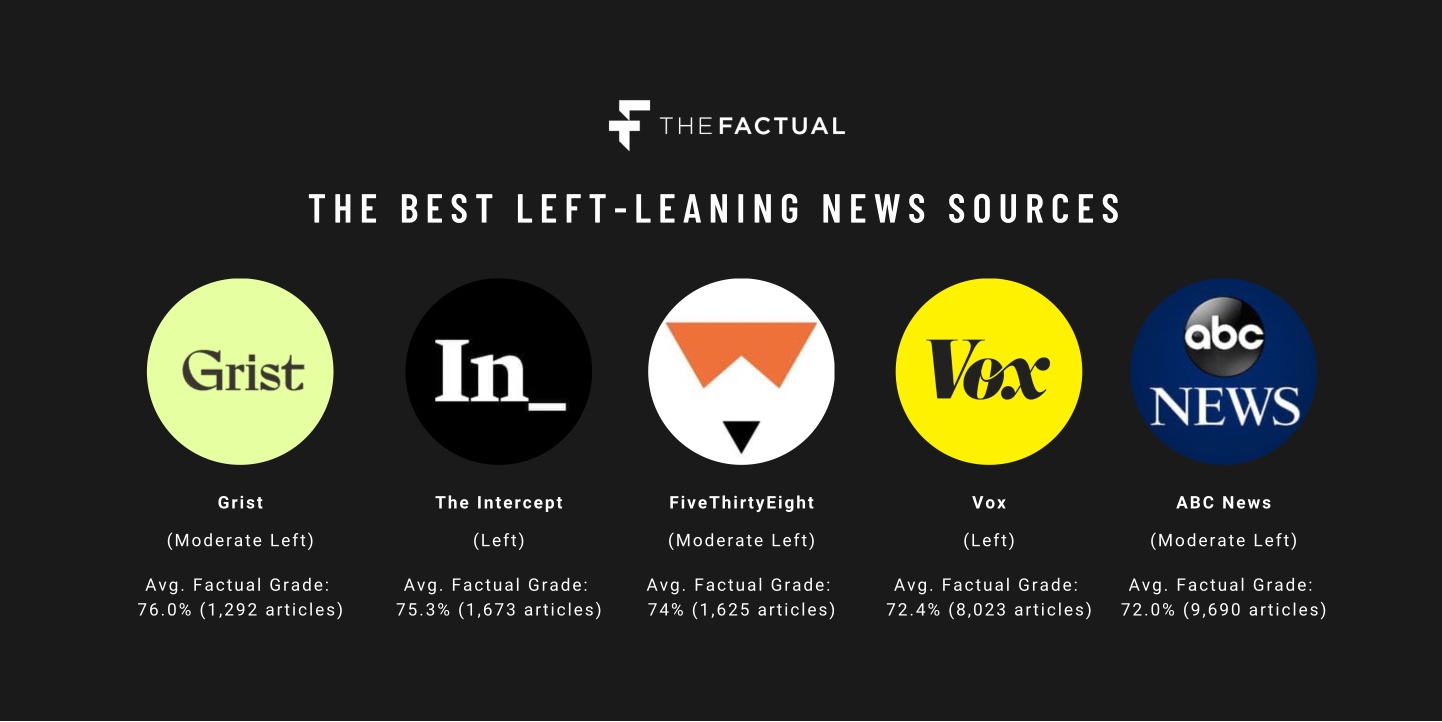For consumers of news from left-leaning viewpoints, the task of finding credible news can be difficult. While news on the right is increasingly restricted to a handful of sources, left-leaning outlets are numerous and varied. As a result, finding the best news to read is increasingly challenging.
The allure of ad revenue incentivizes news sources to publish more frequently. But is good for publishers may not be good for the consumer. Finding well-researched, minimally biased, and credible articles is hard but essential for making daily choices. And everyone deserves the tools to do so.
At The Factual, we provide data to help readers identify the best news sources across the political spectrum. To do so, we built a dataset of over 828,000 articles, representing the (near) total publishing history of 54 major news sources and online publishers from January 1, 2020 to May 18, 2021. Then, we can measure which news sources consistently produce the most credible, highly researched news according to each outlet’s average Factual Grade. This week, we’ve used this dataset to highlight the top five left-leaning news outlets.
Please check your email for instructions to ensure that the newsletter arrives in your inbox tomorrow.
Top 5 News Outlets on the Left
Grist
Average Factual Grade: 76.0% | Number of Articles Scored: 1,292 | Publisher Bias: Moderate Left
Grist is an independent, non-profit media organization that specializes in climate, sustainability, and social justice. Established in 1999, their work has shined bright during the pandemic and in coverage of climate change.
Highest Scoring Article: “Parks combat summer heat. But not everyone has equal access.”
Author: Joseph Winters | Factual Grade: 93%
The Intercept
Average Factual Grade: 75.3% | Number of Articles Scored: 1,673 | Publisher Bias: Left
The Intercept seeks to hold the powerful accountable by pursuing changemaking journalism. Among their best articles are investigations of corruption, criminal justice reform, labor rights, and pollution.
Highest Scoring Article: “Many Immigrant Doctors Want to Fight the Coronavirus, But U.S. Visa Rules Make That Illegal”
Author: Sharon Lerner | Factual Grade: 92%
FiveThirtyEight
Average Factual Grade: 74.0% | Number of Articles Scored: 1,625 | Publisher Bias: Moderate Left
FiveThirtyEight, best known for its data science journalism, had a busy year in 2020 covering the presidential election. However, they also use “statistical analysis — hard numbers — to tell compelling stories” year-round, from the impacts of Covid-19 to the performances of sports franchises.
Highest Scoring Article: “How To Make Indoor Air Safer”
Author: Kaleigh Rogers | Factual Grade: 91%
Vox
Average Factual Grade: 72.4% | Number of Articles Scored: 8,023 | Publisher Bias: Left
Vox is a news website known for its explanatory approach to news. Writers at Vox strive to include additional context to news stories that you might not get from traditional news sources.
Highest Scoring Article: “Covid-19 prevention: The most important variable in reopening schools”
Author: Lois Parshley | Factual Grade: 93%
ABC News
Average Factual Grade: 72.0% | Number of Articles Scored: 9,690 | Publisher Bias: Moderate Left
Despite its larger profile, ABC News is a great spot for high-quality, highly researched journalism. The Disney-owned news outlet publishes a steady stream of content covering general topics in U.S. news.
Highest Scoring Article: “Disparities persist as US tops 500,000 COVID deaths”
Author: Erin Schumaker | Factual Grade: 89%
Where Is the New York Times?
You might be curious about how other major news outlets and key players in the progressive media landscape scored. In a nutshell, they score variably from fairly high to fairly low. Prominence in the media landscape does not seem to be correlated with article credibility, at least as measured by our metrics. CNBC scored 71.5%, the New York Times scored 68.4%, NPR scored 67.2%, the Washington Post scored 66.1%, and CNN scored 53.6%.
How Does The Factual Rank the News?
The Factual’s news-rating algorithm measures how objective (or factual) any news article is based on four metrics. Each answers simple questions about the quality of an article:
- The number and diversity of links and meaningful quotes
Does an article provide ample, diverse evidence? Does it include direct quotations? This metric helps capture whether an article is supported by facts. - The writing tone
Is the article written to educate or infuriate? Is the writing strongly opinionated or trying to convey information? By using natural language processing, this metric can help identify objectivity and subjectivity. - The topical expertise of the author
Has the author written on the topic (e.g., U.S. politics, homeland security, immigration) before? How have past articles by the same author scored? This helps measure whether the author has a reputation of producing credible news on a topic. - The article history of the publishing site
How have other articles from the same source scored? Are they typically well researched? This tells us whether the publishing site has a record of producing quality journalism.
These four metrics make up the Factual Grade for each article. Articles that score 75% or higher are very likely to be credible. That means an article is well researched, written by an author with topical experience, is published by a reputable site, and is written in a neutral tone.
To read more about each metric and how they work together, see our How It Works page or watch this YouTube video.

